Abstract
Genital human papillomavirus (HPV) infection is a common sexually transmitted disease that at the present time is not effectively controlled or treated. Many infections are inapparent and transient. However, some HPV infections result in persistent lesions that in some cases undergo carcinogenic progression. A subset of genital HPVs, designated high-risk types, are preferentially associated with high-grade dysplasias and carcinomas. About 90% of cervical cancers contain high-risk HPV DNA, most often HPV16. Development of a subunit vaccine against high-risk genital HPVs is a desirable and, it appears, an increasingly feasible long-term goal. The viral E6 and E7 oncoproteins are selectively maintained and expressed in progressed HPV tumors and could potentially be targets for therapeutic vaccines. The L1 major virion structural proteins have recently been shown to self-assemble into virus-like particles when expressed in insect cells. These particles might serve as the basis for a prophylactic vaccine to prevent genital HPV infection.
Full text
PDF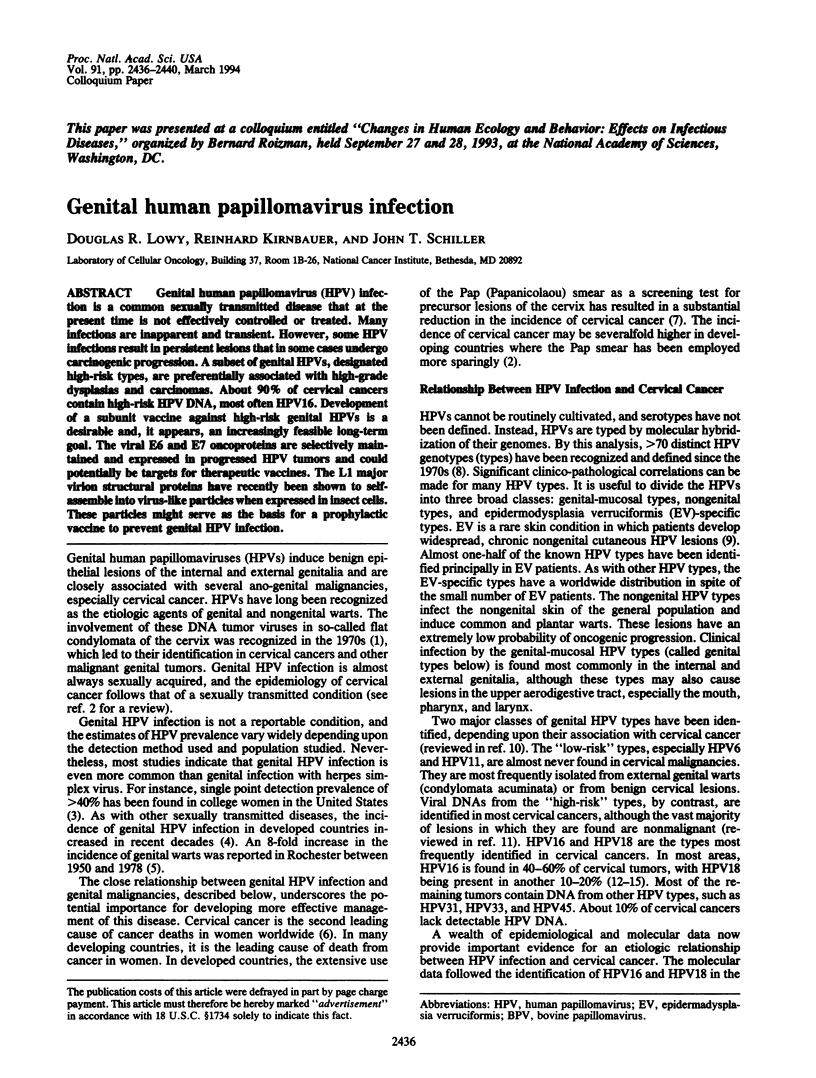
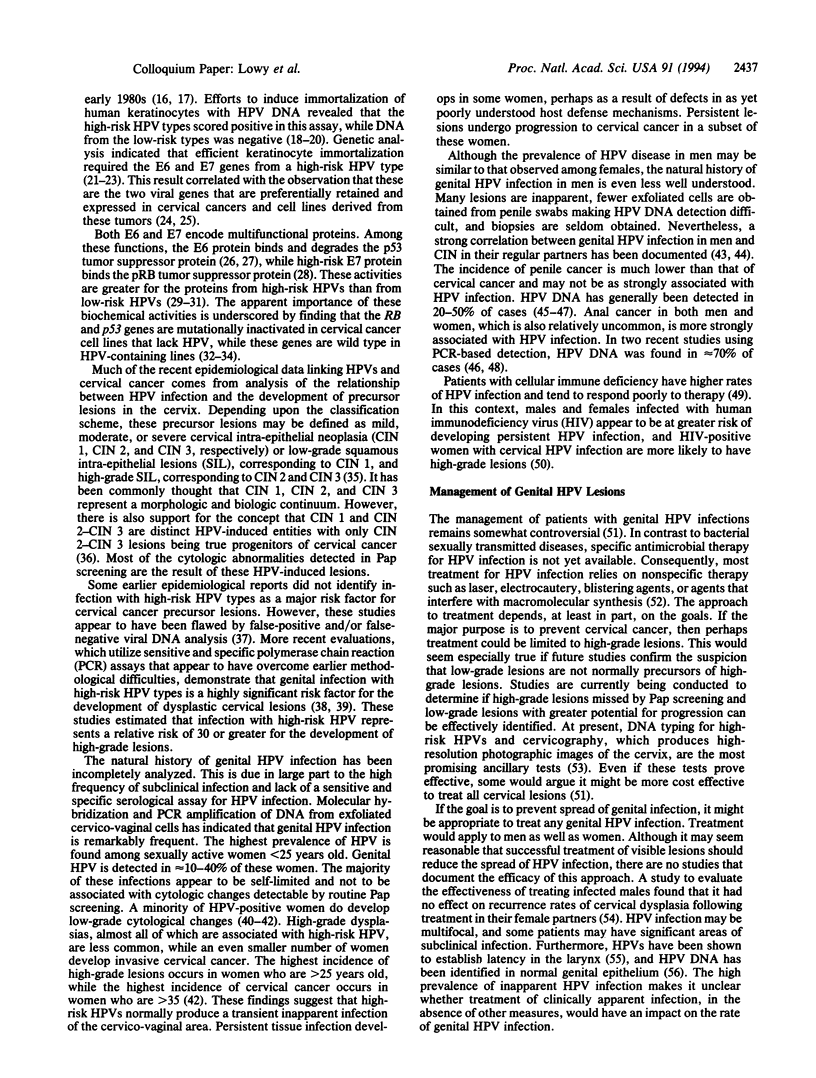
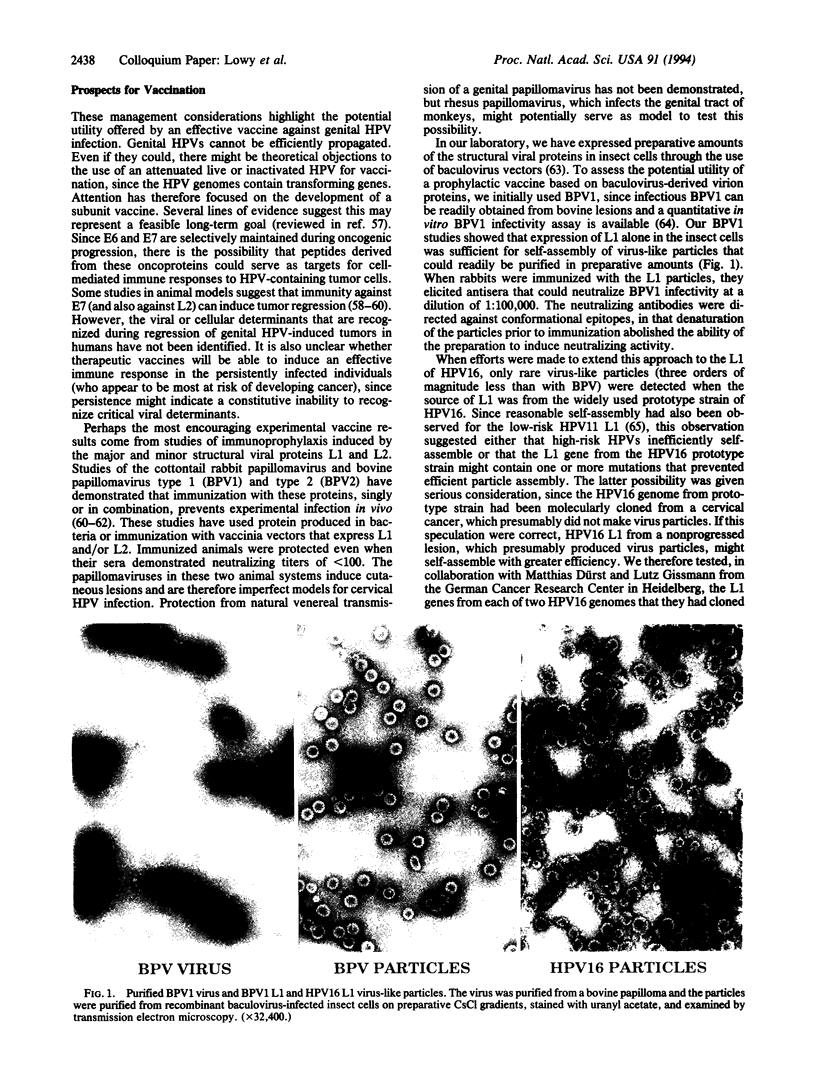
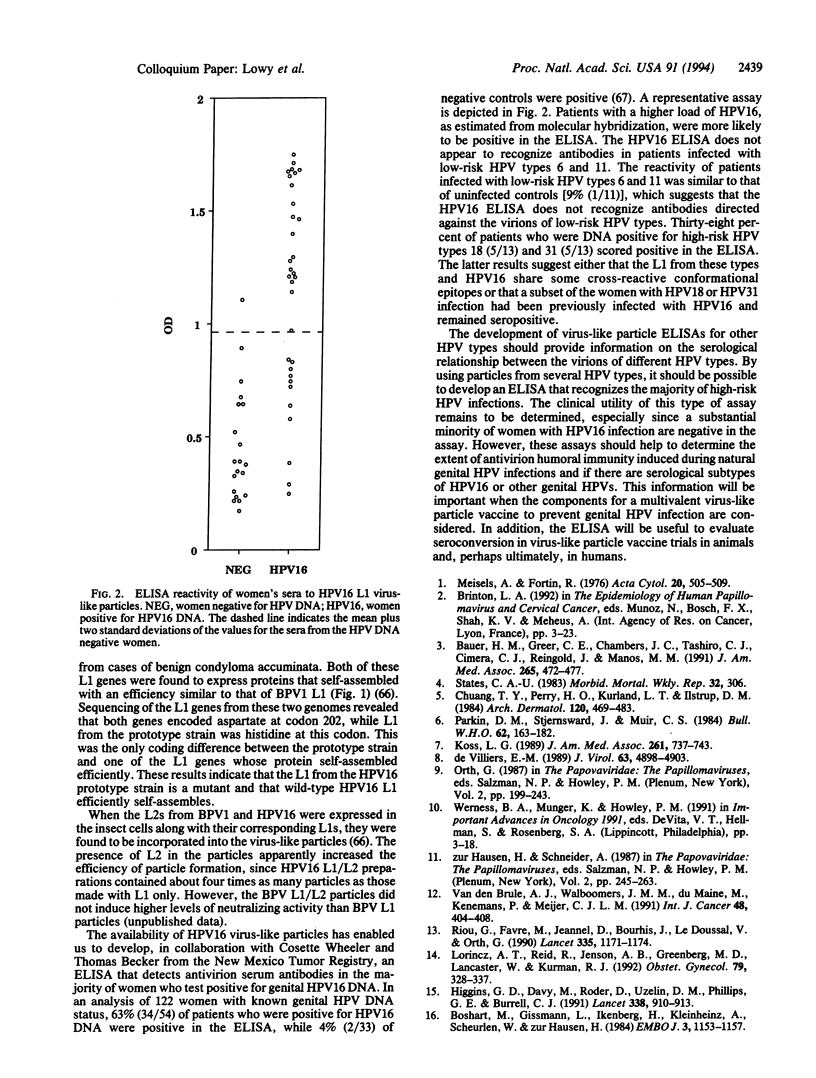
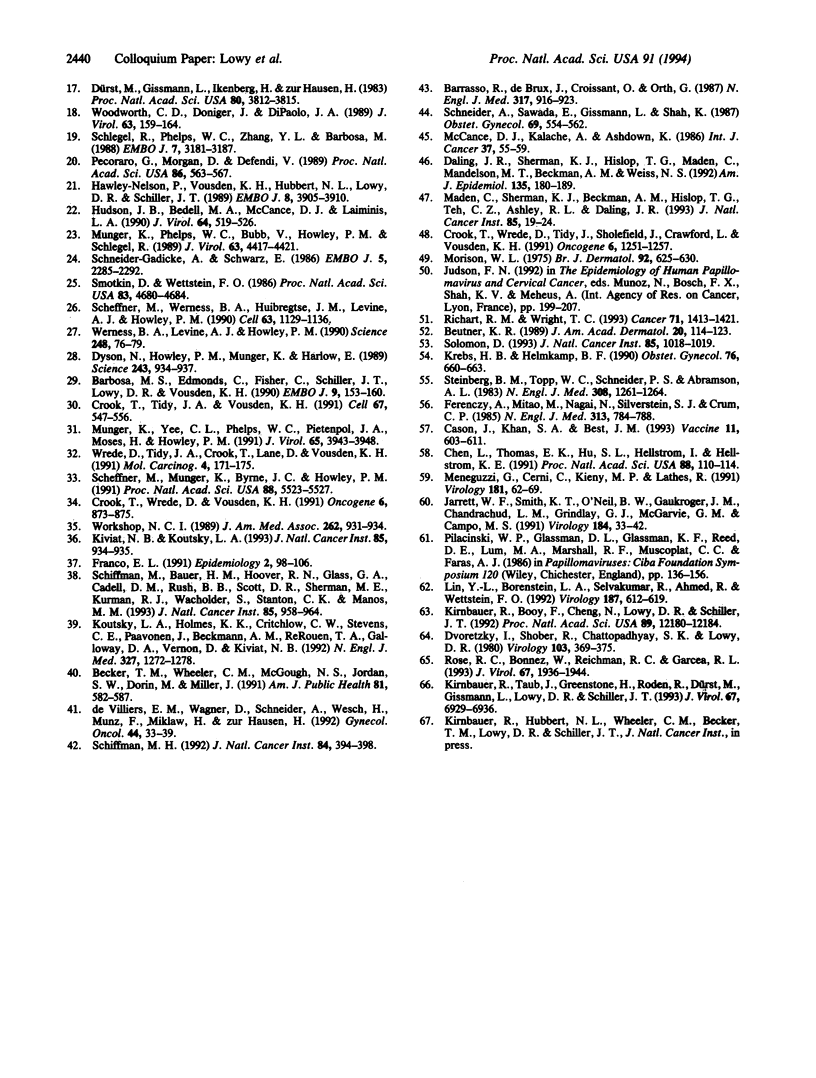
Images in this article
Selected References
These references are in PubMed. This may not be the complete list of references from this article.
- Barbosa M. S., Edmonds C., Fisher C., Schiller J. T., Lowy D. R., Vousden K. H. The region of the HPV E7 oncoprotein homologous to adenovirus E1a and Sv40 large T antigen contains separate domains for Rb binding and casein kinase II phosphorylation. EMBO J. 1990 Jan;9(1):153–160. doi: 10.1002/j.1460-2075.1990.tb08091.x. [DOI] [PMC free article] [PubMed] [Google Scholar]
- Barrasso R., De Brux J., Croissant O., Orth G. High prevalence of papillomavirus-associated penile intraepithelial neoplasia in sexual partners of women with cervical intraepithelial neoplasia. N Engl J Med. 1987 Oct 8;317(15):916–923. doi: 10.1056/NEJM198710083171502. [DOI] [PubMed] [Google Scholar]
- Bauer H. M., Ting Y., Greer C. E., Chambers J. C., Tashiro C. J., Chimera J., Reingold A., Manos M. M. Genital human papillomavirus infection in female university students as determined by a PCR-based method. JAMA. 1991 Jan 23;265(4):472–477. [PubMed] [Google Scholar]
- Becker T. M., Wheeler C. M., McGough N. S., Jordan S. W., Dorin M., Miller J. Cervical papillomavirus infection and cervical dysplasia in Hispanic, Native American, and non-Hispanic white women in New Mexico. Am J Public Health. 1991 May;81(5):582–586. doi: 10.2105/ajph.81.5.582. [DOI] [PMC free article] [PubMed] [Google Scholar]
- Beutner K. R. Human papillomavirus infection. J Am Acad Dermatol. 1989 Jan;20(1):114–123. doi: 10.1016/s0190-9622(89)80004-0. [DOI] [PubMed] [Google Scholar]
- Boshart M., Gissmann L., Ikenberg H., Kleinheinz A., Scheurlen W., zur Hausen H. A new type of papillomavirus DNA, its presence in genital cancer biopsies and in cell lines derived from cervical cancer. EMBO J. 1984 May;3(5):1151–1157. doi: 10.1002/j.1460-2075.1984.tb01944.x. [DOI] [PMC free article] [PubMed] [Google Scholar]
- Cason J., Khan S. A., Best J. M. Towards vaccines against human papillomavirus type-16 genital infections. Vaccine. 1993;11(6):603–611. doi: 10.1016/0264-410x(93)90302-e. [DOI] [PubMed] [Google Scholar]
- Chen L. P., Thomas E. K., Hu S. L., Hellström I., Hellström K. E. Human papillomavirus type 16 nucleoprotein E7 is a tumor rejection antigen. Proc Natl Acad Sci U S A. 1991 Jan 1;88(1):110–114. doi: 10.1073/pnas.88.1.110. [DOI] [PMC free article] [PubMed] [Google Scholar]
- Chuang T. Y., Perry H. O., Kurland L. T., Ilstrup D. M. Condyloma acuminatum in Rochester, Minn, 1950-1978. II. Anaplasias and unfavorable outcomes. Arch Dermatol. 1984 Apr;120(4):476–483. [PubMed] [Google Scholar]
- Crook T., Tidy J. A., Vousden K. H. Degradation of p53 can be targeted by HPV E6 sequences distinct from those required for p53 binding and trans-activation. Cell. 1991 Nov 1;67(3):547–556. doi: 10.1016/0092-8674(91)90529-8. [DOI] [PubMed] [Google Scholar]
- Crook T., Wrede D., Tidy J., Scholefield J., Crawford L., Vousden K. H. Status of c-myc, p53 and retinoblastoma genes in human papillomavirus positive and negative squamous cell carcinomas of the anus. Oncogene. 1991 Jul;6(7):1251–1257. [PubMed] [Google Scholar]
- Crook T., Wrede D., Vousden K. H. p53 point mutation in HPV negative human cervical carcinoma cell lines. Oncogene. 1991 May;6(5):873–875. [PubMed] [Google Scholar]
- Daling J. R., Sherman K. J., Hislop T. G., Maden C., Mandelson M. T., Beckmann A. M., Weiss N. S. Cigarette smoking and the risk of anogenital cancer. Am J Epidemiol. 1992 Jan 15;135(2):180–189. doi: 10.1093/oxfordjournals.aje.a116270. [DOI] [PubMed] [Google Scholar]
- Dvoretzky I., Shober R., Chattopadhyay S. K., Lowy D. R. A quantitative in vitro focus assay for bovine papilloma virus. Virology. 1980 Jun;103(2):369–375. doi: 10.1016/0042-6822(80)90195-6. [DOI] [PubMed] [Google Scholar]
- Dyson N., Howley P. M., Münger K., Harlow E. The human papilloma virus-16 E7 oncoprotein is able to bind to the retinoblastoma gene product. Science. 1989 Feb 17;243(4893):934–937. doi: 10.1126/science.2537532. [DOI] [PubMed] [Google Scholar]
- Dürst M., Gissmann L., Ikenberg H., zur Hausen H. A papillomavirus DNA from a cervical carcinoma and its prevalence in cancer biopsy samples from different geographic regions. Proc Natl Acad Sci U S A. 1983 Jun;80(12):3812–3815. doi: 10.1073/pnas.80.12.3812. [DOI] [PMC free article] [PubMed] [Google Scholar]
- Ferenczy A., Mitao M., Nagai N., Silverstein S. J., Crum C. P. Latent papillomavirus and recurring genital warts. N Engl J Med. 1985 Sep 26;313(13):784–788. doi: 10.1056/NEJM198509263131304. [DOI] [PubMed] [Google Scholar]
- Franco E. L. The sexually transmitted disease model for cervical cancer: incoherent epidemiologic findings and the role of misclassification of human papillomavirus infection. Epidemiology. 1991 Mar;2(2):98–106. [PubMed] [Google Scholar]
- Hawley-Nelson P., Vousden K. H., Hubbert N. L., Lowy D. R., Schiller J. T. HPV16 E6 and E7 proteins cooperate to immortalize human foreskin keratinocytes. EMBO J. 1989 Dec 1;8(12):3905–3910. doi: 10.1002/j.1460-2075.1989.tb08570.x. [DOI] [PMC free article] [PubMed] [Google Scholar]
- Higgins G. D., Davy M., Roder D., Uzelin D. M., Phillips G. E., Burrell C. J. Increased age and mortality associated with cervical carcinomas negative for human papillomavirus RNA. Lancet. 1991 Oct 12;338(8772):910–913. doi: 10.1016/0140-6736(91)91773-n. [DOI] [PubMed] [Google Scholar]
- Hudson J. B., Bedell M. A., McCance D. J., Laiminis L. A. Immortalization and altered differentiation of human keratinocytes in vitro by the E6 and E7 open reading frames of human papillomavirus type 18. J Virol. 1990 Feb;64(2):519–526. doi: 10.1128/jvi.64.2.519-526.1990. [DOI] [PMC free article] [PubMed] [Google Scholar]
- Jarrett W. F., Smith K. T., O'Neil B. W., Gaukroger J. M., Chandrachud L. M., Grindlay G. J., McGarvie G. M., Campo M. S. Studies on vaccination against papillomaviruses: prophylactic and therapeutic vaccination with recombinant structural proteins. Virology. 1991 Sep;184(1):33–42. doi: 10.1016/0042-6822(91)90819-w. [DOI] [PubMed] [Google Scholar]
- Kirnbauer R., Booy F., Cheng N., Lowy D. R., Schiller J. T. Papillomavirus L1 major capsid protein self-assembles into virus-like particles that are highly immunogenic. Proc Natl Acad Sci U S A. 1992 Dec 15;89(24):12180–12184. doi: 10.1073/pnas.89.24.12180. [DOI] [PMC free article] [PubMed] [Google Scholar]
- Kirnbauer R., Taub J., Greenstone H., Roden R., Dürst M., Gissmann L., Lowy D. R., Schiller J. T. Efficient self-assembly of human papillomavirus type 16 L1 and L1-L2 into virus-like particles. J Virol. 1993 Dec;67(12):6929–6936. doi: 10.1128/jvi.67.12.6929-6936.1993. [DOI] [PMC free article] [PubMed] [Google Scholar]
- Kiviat N. B., Koutsky L. A. Specific human papillomavirus types as the causal agents of most cervical intraepithelial neoplasia: implications for current views and treatment. J Natl Cancer Inst. 1993 Jun 16;85(12):934–935. doi: 10.1093/jnci/85.12.934. [DOI] [PubMed] [Google Scholar]
- Koss L. G. The Papanicolaou test for cervical cancer detection. A triumph and a tragedy. JAMA. 1989 Feb 3;261(5):737–743. [PubMed] [Google Scholar]
- Koutsky L. A., Holmes K. K., Critchlow C. W., Stevens C. E., Paavonen J., Beckmann A. M., DeRouen T. A., Galloway D. A., Vernon D., Kiviat N. B. A cohort study of the risk of cervical intraepithelial neoplasia grade 2 or 3 in relation to papillomavirus infection. N Engl J Med. 1992 Oct 29;327(18):1272–1278. doi: 10.1056/NEJM199210293271804. [DOI] [PubMed] [Google Scholar]
- Krebs H. B., Helmkamp B. F. Does the treatment of genital condylomata in men decrease the treatment failure rate of cervical dysplasia in the female sexual partner? Obstet Gynecol. 1990 Oct;76(4):660–663. [PubMed] [Google Scholar]
- Lin Y. L., Borenstein L. A., Selvakumar R., Ahmed R., Wettstein F. O. Effective vaccination against papilloma development by immunization with L1 or L2 structural protein of cottontail rabbit papillomavirus. Virology. 1992 Apr;187(2):612–619. doi: 10.1016/0042-6822(92)90463-y. [DOI] [PubMed] [Google Scholar]
- Lorincz A. T., Reid R., Jenson A. B., Greenberg M. D., Lancaster W., Kurman R. J. Human papillomavirus infection of the cervix: relative risk associations of 15 common anogenital types. Obstet Gynecol. 1992 Mar;79(3):328–337. doi: 10.1097/00006250-199203000-00002. [DOI] [PubMed] [Google Scholar]
- Maden C., Sherman K. J., Beckmann A. M., Hislop T. G., Teh C. Z., Ashley R. L., Daling J. R. History of circumcision, medical conditions, and sexual activity and risk of penile cancer. J Natl Cancer Inst. 1993 Jan 6;85(1):19–24. doi: 10.1093/jnci/85.1.19. [DOI] [PubMed] [Google Scholar]
- McCance D. J., Kalache A., Ashdown K., Andrade L., Menezes F., Smith P., Doll R. Human papillomavirus types 16 and 18 in carcinomas of the penis from Brazil. Int J Cancer. 1986 Jan 15;37(1):55–59. doi: 10.1002/ijc.2910370110. [DOI] [PubMed] [Google Scholar]
- Meisels A., Fortin R. Condylomatous lesions of the cervix and vagina. I. Cytologic patterns. Acta Cytol. 1976 Nov-Dec;20(6):505–509. [PubMed] [Google Scholar]
- Meneguzzi G., Cerni C., Kieny M. P., Lathe R. Immunization against human papillomavirus type 16 tumor cells with recombinant vaccinia viruses expressing E6 and E7. Virology. 1991 Mar;181(1):62–69. doi: 10.1016/0042-6822(91)90470-v. [DOI] [PubMed] [Google Scholar]
- Morison W. L. Viral warts, herpes simplex and herpes zoster in patients with secondary immune deficiencies and neoplasms. Br J Dermatol. 1975 Jun;92(6):625–630. doi: 10.1111/j.1365-2133.1975.tb03141.x. [DOI] [PubMed] [Google Scholar]
- Münger K., Phelps W. C., Bubb V., Howley P. M., Schlegel R. The E6 and E7 genes of the human papillomavirus type 16 together are necessary and sufficient for transformation of primary human keratinocytes. J Virol. 1989 Oct;63(10):4417–4421. doi: 10.1128/jvi.63.10.4417-4421.1989. [DOI] [PMC free article] [PubMed] [Google Scholar]
- Münger K., Yee C. L., Phelps W. C., Pietenpol J. A., Moses H. L., Howley P. M. Biochemical and biological differences between E7 oncoproteins of the high- and low-risk human papillomavirus types are determined by amino-terminal sequences. J Virol. 1991 Jul;65(7):3943–3948. doi: 10.1128/jvi.65.7.3943-3948.1991. [DOI] [PMC free article] [PubMed] [Google Scholar]
- Parkin D. M., Stjernswärd J., Muir C. S. Estimates of the worldwide frequency of twelve major cancers. Bull World Health Organ. 1984;62(2):163–182. [PMC free article] [PubMed] [Google Scholar]
- Pecoraro G., Morgan D., Defendi V. Differential effects of human papillomavirus type 6, 16, and 18 DNAs on immortalization and transformation of human cervical epithelial cells. Proc Natl Acad Sci U S A. 1989 Jan;86(2):563–567. doi: 10.1073/pnas.86.2.563. [DOI] [PMC free article] [PubMed] [Google Scholar]
- Pilacinski W. P., Glassman D. L., Glassman K. F., Reed D. E., Lum M. A., Marshall R. F., Muscoplat C. C., Faras A. J. Immunization against bovine papillomavirus infection. Ciba Found Symp. 1986;120:136–156. doi: 10.1002/9780470513309.ch10. [DOI] [PubMed] [Google Scholar]
- Richart R. M., Wright T. C., Jr Controversies in the management of low-grade cervical intraepithelial neoplasia. Cancer. 1993 Feb 15;71(4 Suppl):1413–1421. doi: 10.1002/cncr.2820710406. [DOI] [PubMed] [Google Scholar]
- Riou G., Favre M., Jeannel D., Bourhis J., Le Doussal V., Orth G. Association between poor prognosis in early-stage invasive cervical carcinomas and non-detection of HPV DNA. Lancet. 1990 May 19;335(8699):1171–1174. doi: 10.1016/0140-6736(90)92693-c. [DOI] [PubMed] [Google Scholar]
- Rose R. C., Bonnez W., Reichman R. C., Garcea R. L. Expression of human papillomavirus type 11 L1 protein in insect cells: in vivo and in vitro assembly of viruslike particles. J Virol. 1993 Apr;67(4):1936–1944. doi: 10.1128/jvi.67.4.1936-1944.1993. [DOI] [PMC free article] [PubMed] [Google Scholar]
- Scheffner M., Münger K., Byrne J. C., Howley P. M. The state of the p53 and retinoblastoma genes in human cervical carcinoma cell lines. Proc Natl Acad Sci U S A. 1991 Jul 1;88(13):5523–5527. doi: 10.1073/pnas.88.13.5523. [DOI] [PMC free article] [PubMed] [Google Scholar]
- Scheffner M., Werness B. A., Huibregtse J. M., Levine A. J., Howley P. M. The E6 oncoprotein encoded by human papillomavirus types 16 and 18 promotes the degradation of p53. Cell. 1990 Dec 21;63(6):1129–1136. doi: 10.1016/0092-8674(90)90409-8. [DOI] [PubMed] [Google Scholar]
- Schiffman M. H., Bauer H. M., Hoover R. N., Glass A. G., Cadell D. M., Rush B. B., Scott D. R., Sherman M. E., Kurman R. J., Wacholder S. Epidemiologic evidence showing that human papillomavirus infection causes most cervical intraepithelial neoplasia. J Natl Cancer Inst. 1993 Jun 16;85(12):958–964. doi: 10.1093/jnci/85.12.958. [DOI] [PubMed] [Google Scholar]
- Schiffman M. H. Recent progress in defining the epidemiology of human papillomavirus infection and cervical neoplasia. J Natl Cancer Inst. 1992 Mar 18;84(6):394–398. doi: 10.1093/jnci/84.6.394. [DOI] [PubMed] [Google Scholar]
- Schlegel R., Phelps W. C., Zhang Y. L., Barbosa M. Quantitative keratinocyte assay detects two biological activities of human papillomavirus DNA and identifies viral types associated with cervical carcinoma. EMBO J. 1988 Oct;7(10):3181–3187. doi: 10.1002/j.1460-2075.1988.tb03185.x. [DOI] [PMC free article] [PubMed] [Google Scholar]
- Schneider-Gädicke A., Schwarz E. Different human cervical carcinoma cell lines show similar transcription patterns of human papillomavirus type 18 early genes. EMBO J. 1986 Sep;5(9):2285–2292. doi: 10.1002/j.1460-2075.1986.tb04496.x. [DOI] [PMC free article] [PubMed] [Google Scholar]
- Schneider A., Sawada E., Gissmann L., Shah K. Human papillomaviruses in women with a history of abnormal Papanicolaou smears and in their male partners. Obstet Gynecol. 1987 Apr;69(4):554–562. [PubMed] [Google Scholar]
- Smotkin D., Wettstein F. O. Transcription of human papillomavirus type 16 early genes in a cervical cancer and a cancer-derived cell line and identification of the E7 protein. Proc Natl Acad Sci U S A. 1986 Jul;83(13):4680–4684. doi: 10.1073/pnas.83.13.4680. [DOI] [PMC free article] [PubMed] [Google Scholar]
- Solomon D. Screening for cervical cancer: prospects for the future. J Natl Cancer Inst. 1993 Jul 7;85(13):1018–1019. doi: 10.1093/jnci/85.13.1018. [DOI] [PubMed] [Google Scholar]
- Steinberg B. M., Topp W. C., Schneider P. S., Abramson A. L. Laryngeal papillomavirus infection during clinical remission. N Engl J Med. 1983 May 26;308(21):1261–1264. doi: 10.1056/NEJM198305263082104. [DOI] [PubMed] [Google Scholar]
- The 1988 Bethesda System for reporting cervical/vaginal cytological diagnoses. National Cancer Institute Workshop. JAMA. 1989 Aug 18;262(7):931–934. [PubMed] [Google Scholar]
- Van Den Brule A. J., Walboomers J. M., Du Maine M., Kenemans P., Meijer C. J. Difference in prevalence of human papillomavirus genotypes in cytomorphologically normal cervical smears is associated with a history of cervical intraepithelial neoplasia. Int J Cancer. 1991 May 30;48(3):404–408. doi: 10.1002/ijc.2910480317. [DOI] [PubMed] [Google Scholar]
- Werness B. A., Levine A. J., Howley P. M. Association of human papillomavirus types 16 and 18 E6 proteins with p53. Science. 1990 Apr 6;248(4951):76–79. doi: 10.1126/science.2157286. [DOI] [PubMed] [Google Scholar]
- Woodworth C. D., Doniger J., DiPaolo J. A. Immortalization of human foreskin keratinocytes by various human papillomavirus DNAs corresponds to their association with cervical carcinoma. J Virol. 1989 Jan;63(1):159–164. doi: 10.1128/jvi.63.1.159-164.1989. [DOI] [PMC free article] [PubMed] [Google Scholar]
- Wrede D., Tidy J. A., Crook T., Lane D., Vousden K. H. Expression of RB and p53 proteins in HPV-positive and HPV-negative cervical carcinoma cell lines. Mol Carcinog. 1991;4(3):171–175. doi: 10.1002/mc.2940040302. [DOI] [PubMed] [Google Scholar]
- de Villiers E. M. Heterogeneity of the human papillomavirus group. J Virol. 1989 Nov;63(11):4898–4903. doi: 10.1128/jvi.63.11.4898-4903.1989. [DOI] [PMC free article] [PubMed] [Google Scholar]
- de Villiers E. M., Wagner D., Schneider A., Wesch H., Munz F., Miklaw H., zur Hausen H. Human papillomavirus DNA in women without and with cytological abnormalities: results of a 5-year follow-up study. Gynecol Oncol. 1992 Jan;44(1):33–39. doi: 10.1016/0090-8258(92)90008-7. [DOI] [PubMed] [Google Scholar]



